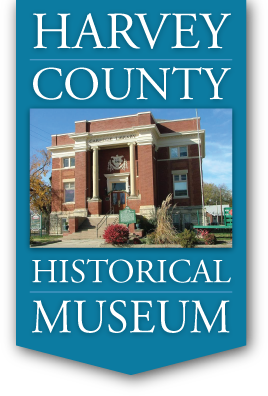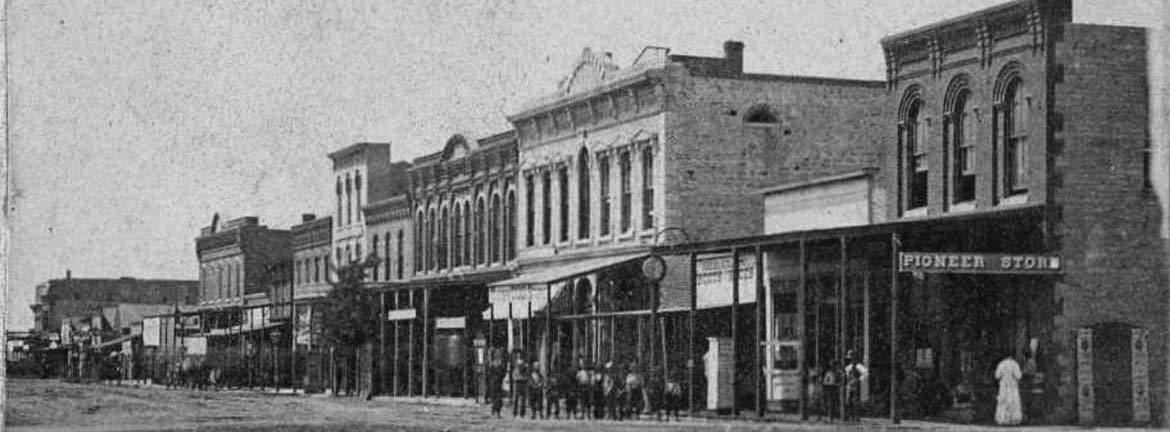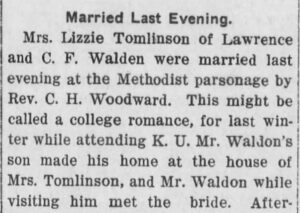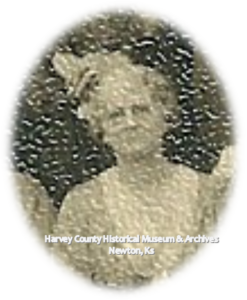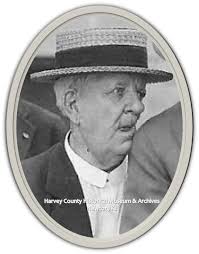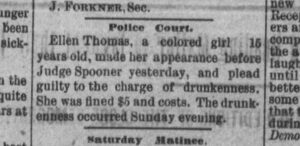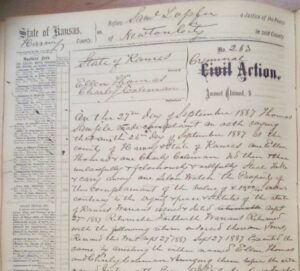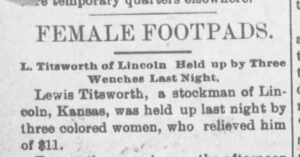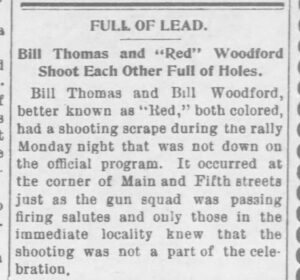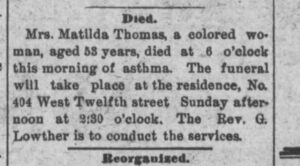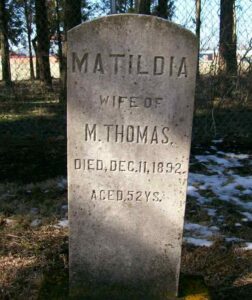For August we are celebrating! On August 26, 1920 the 19th Amendment to the United States Constitution giving women the right to vote nationally was adopted. In Kansas, women could vote in state elections since 1912.
For the next several weeks, we will highlight some of the women of Harvey County that worked on suffrage for Kansas.
Sometimes it is a challenge to put the pieces of their lives together to get an idea of who these women were beyond the name, which was often their husband’s.
The first woman we will feature is Mrs. C. F. Walden. Her name appears in connection to suffrage. Although her name appears, the story of Mrs. C. F. Walden. is not is not a straight forward one, and ends up spanning several communities and two marriages.
Elizabeth Porter, or Lizzie, was born in Peoria County, Ill October 9, 1868 to Irish immigrants John and Sarah Porter. The 1870 U.S. Census lists five children for the family. By 1880, her father had died and her mother had remarried a man by the name of John Coleman. The family continued to live in Millbrook, Ill. Information on her life is scarce for the next nineteen years. Sometime between 1880 and 1899, she found her way to Miami County, Kansas where she met a widower, Ralph Tomlinson.
Farm of 80 Acres
Lizzie married Ralph Tomlinson on January 17, 1899. The couple made their home on a farm six miles southwest of Paola, Ks in Stanton Township. Ralph had a son, Clifford, from a previous marriage and the couple had one son together, Raymond. The extended Tomlinson family had settled in the area in the 1870s and Ralph was known as “a hard-working man, had no bad habits, was honest and reliable, a man in whom dependence could be placed at all times.” However, in 1906 he was “afflicted with kidney trouble, which affected his brain.” He went to the Osawatomie State hospital for treatment and was deemed cured in June 1906 and returned home.
Tragedy struck the Tomlinson farm after the new year. After lunch on Monday, February 22, 1907, Lizzie Tomlinson dropped her youngest son off at a neighbor so she could go to Paola to “do some trading.” When the eldest son returned home from school, he completed some of his chores and went to the barn “and found his father dead.” The Miami Republican later reported the findings of the coroner “Ralph Tomlinson, a well-known farmer committed suicide by hanging in the barn on his farm.”
Lizzie Tomlinson was the mother of two with a 80 acre farm to care for. Clifford, at 18, could provide a great deal of help and no doubt Ralph’s extended family also lent a hand but by 1909, Lizzie was ready to move from the farm.
The Miami Republican reported that Mres. Lizzie Tomlinson purchased “a modern residence property of nine rooms at 2115 Tennessee street, for which she paid $4,500. . . and will remove to Lawrence soon afterwards, to educate her sons.”
In September 1909, she put the farm up for rent and held a sale of personal property.
While in Lawrence, Mrs. Tomlinson operated a boarding house for University of Kansas students at 2115 Tennessee.
College Romance
In the winter of 1910, there were several young men from Newton attending KU that had rooms with Mrs. Tomlinson and over the course of the semester she became acquainted with their parents.
One of the students was Forest Walden. Later, it was observed that “it seemed that Forest Walden was especially favored by paternal calls. Mr. Walden’s motives may have been merely fatherly interest, but recent events lead one to think otherwise.” There seemed to be a different kind of “college romance” developing. Forest’s father, Charles F. Walden and Mrs Lizzie Tomlinson married on June 28, 1910 at the home of Rev. C.H. Woodward.
Charles F. Walden had come to Kansas with his first wife, Hattie, shortly after their marriage in 1885. They settled in the Walton area and had four children, two of which died in infancy. By 1903, the Walden family had moved to a home in Newton at 901 E 7th. In March 1908, Hattie, who seemed have suffered for some time from “declining health and strength and had been for several months confined to her room” died “not unexpectedly” at the age of 51. (Newton Kansan, 12 March 1908) She was survived by her husband Charles, and two sons, Francis and Forest. So, just like Mrs. Tomlinson, Mr. C.F. Walden was in search of a companion.
The story of the “College Romance” concluded that“Mrs. Walden is not so well known to Newton people but there is no doubt she will soon find as good friends as she has in the boys who were with her last winter.”
We Have the Right to Blow Our Horn
She did indeed get involved in various women’s groups including those working for suffrage, notably the Women’s Christian Temperance Union (W.C.T.U.). Perhaps better known for their interest in prohibition, the W.T.C.U.was also active in promoting suffrage.
Soon after her marriage and move to Newton, Mrs. Walden became involved in the W.C.T.U. In 1912, she served as the superintendent for suffrage for the W.C.T.U. Mrs. Walden was the county president in 1916 and 1920.
At the 1915 meeting of the W.C.T.U. in Newton a new yell was composed.
“Kansas wheat, Kansas corn
We have the right to blow our horn,
Prohibition and suffrage, too,
Kansas W.C.T.U.
Hurrah Hurrah Hurrah!”
Jan 20, 1922 sixty members of the W.C.T.U. met at the home of Mrs. C. F. Walden to celebrate National Prohibition. The guest of honor was Mrs. F. L. Greer who worked with the Prison Welfare association. She commended the Newton union for the work done in cooperation with the Parent Teachers’ associations and organizing Loyal Temperance Legions. (Newton Kansan 20 January 1922)
Mrs. C.F. Walden was also active in the Themian Club.
Like many other women of the time, Mrs. C. F. Walden was active behind the scenes. Her name, cloaked by her husband’s, appeared when she served in an official capacity, but otherwise she is one of the nameless many who worked for suffrage in Kansas.
The Walden’s continued to live at the 901 E 7th residence until 1944. At that time, Mrs. Elizabeth Walden, once again a widow, moved to Texas. She died January 1948 at the age of 79 and was buried with her first husband Ralph Tomlinson in the Paola Cemetery, Miami County, Ks.
Additional Sources:
- Lawrence Daily World: 29 September 1909, 27 September 1909, 4 January 1910.
- Miami Republican: 2 February 1907, 20 August 1909, 1 September 1909.
- Newton Kansan: 29 November 1901, 6 December 1901, 23 January 1903, 12 March 1908, 1 July 1909, 1 July 1910, 19 September 1912, 23 September 1915, 14 September 1916, 15 October 1920, 20 January 1922.
- Walden, C. F. to Tomlinson, Lizzie 28 June 1910 Marriage Certificate Collection HCHM Archives
- Newton City Directories: 1905, 1911, 1913, 1919, 1931, 1934, 1938, 1940, 1943, 1946.
- Find A Grave: Elizabeth Porter Tomlinson (1868-1948); Ralph Tomlinson (1860-1907); Hattie I. Farmer Walden (1857-1908).
- U.S. Census: 1870, 1880, 1900, 1910,
- Kansas County Marriages 1855-1911.
